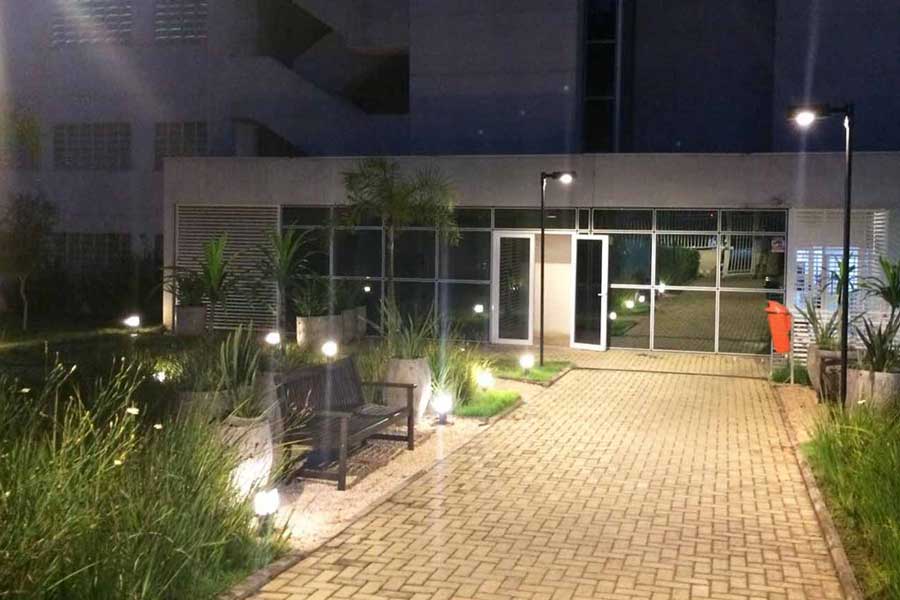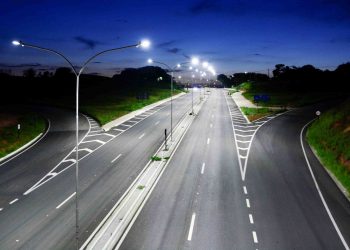
Learn what to consider for your condominium lighting project
Professionals who deal with condominium lighting need to apply specific techniques that increase effectiveness, safety, and economy regarding the organization of lights in this type of establishment.
Continue reading to learn more about the subject. Here you will find the concept and purpose of lighting in condominiums, the regulations that deal with the topic, the best practices for indoor and outdoor lighting, and more.
What is, what is the purpose, and how does condominium lighting work?
Condominium lighting involves all the criteria of a lighting project for the common areas of a condominium, whether it is a commercial or residential building. In practice, aspects such as:
- Positioning of light sources;
- Where natural lighting will be used;
- Luminance level, contrast, color, and others;
- Factors related to equipment maintenance;
- Equipment used to control the activation of lights and their intensities, among others.
Its main purpose is to ensure a quality environment for individuals to move around and perform their activities within the location. If there are any doubts about which are the private areas, the responsible person can check the delineations of the areas in documents such as the Condominium Convention, the property plan, or the real estate certificate.
What are the main regulations on the subject, and what do they bring?
There are two main regulations that bring general provisions on condominium lighting. See what they are below.
ABNT NBR 8995-1
NBR/ISO 8995-1 of 2013 brings the legal requirements for maintaining lighting in internal workspaces, as well as the requirements for performing visual tasks more efficiently, safely, and comfortably during the activities.
This is a very broad standard and should be applied in environments such as the entrance hall, waiting room, stairs, dining rooms, rest rooms, storage rooms, control and auxiliary rooms, among others.
Resolution 414/10 ANEEL
ANEEL regulates and supervises the production, transmission, distribution, and commercialization of electrical energy, in addition to improving the conditions of this market. Thus, this is the competent entity to publish the general conditions on electrical energy and lighting, which consist of Resolution 414/10 ANEEL.
According to article 20 of the standard, it is the responsibility of the municipal or district public authorities to provide lighting for internal condominium streets, and the public lighting professional should apply what the resolution provides in this type of entity.
Another important ANEEL resolution is 2590/2019, which brings the average time for billing the electrical energy that should be allocated to the lighting of internal condominium streets. Resolution no. 888/2020 ANEEL was also published, which brings greater security and cost predictability to the Electrical Sector and Municipalities.
ABNT NBR 5101
Regarding internal streets, residential or even industrial condominiums must comply with what is provided in ABNT NBR 5101.
The standard was revised in 2018, and its purpose is to provide more safety for pedestrian and vehicle traffic. It provides for the distribution of transverse, longitudinal, and luminous intensities in spaces above 80 and 90-degree cones.
It should be noted that internal roads are the responsibility of the company that manages the condominium, as they are not public roads.
What are the best practices for condominium lighting?
In this topic, there are tips that improve indoor condominium environments, providing greater comfort to people who move around the location and a better environment for visual tasks.
Avoid very high or low luminances
Luminance (SI) is the measure of the density of the intensity of light reflected in a direction. Avoid it being too high so that people’s vision does not suffer from glare, which generates discomfort and reduces visual acuity.
Be careful with luminance contrasts.
Contrasts are the differences in luminances in the environment. If the change in luminance level is impactful between environments, there will be greater visual fatigue, as the eyes will need to constantly readapt when an individual crosses environments.
Note that the luminances of different places should be uniform, of similar levels or provide a gradual and pleasant transition.
Analyze color aspects.
There are two color-related characteristics that should be analyzed. The first is the appearance of color, which involves the chromaticity of the light it emits and can be categorized into three groups that vary according to the temperature of the lamps:
- Warm – up to 3,300 Kelvin (K); Intermediate – between 3,300 K and 5,300 K;
- Cold – above 5,300 K.
To make the right choice, it is important to analyze the climate of the local environment. For example, in warm climates, the use of cool colors is recommended. Warm colors are preferred for cold places.
The second aspect of color is its ability to reproduce, which is measured in Ra, has a maximum value of 100 and influences the well-being of the environment. In interiors where individuals stay for long periods, it is not recommended to use lights below 80.
Study each zone individually.
As each area of the condominium has its own characteristics, lighting will not have the same uniform impact on the entity. It is necessary to study the qualities of each area separately and create the best plan for each one.
What are the best practices for performance and economy in outdoor lighting?
It is also important to pay attention to the lighting of the external part of the condominium – outside – as this can also impact the consumption of electricity.
Install sensors.
Often people forget to turn off lights or keep them on longer than necessary, which can generate a significant increase in electricity expenses. This problem can be avoided by implementing sensors that detect movement, activate automatically, and are deactivated after a period of time.
Take advantage of natural lighting.
By increasing the use of natural light, the need to keep lights active decreases. There are different strategies that can be applied to achieve this goal; one of them is by applying a dimming system – regulating the power of the luminaires according to the momentary need.
Use LED lighting.
Luminaires that use LED crystals have greater power and, especially, are more economical. Another reduction in expenses involves the decrease in the need for maintenance, as LED luminaires have a longer lifespan.
These benefits are possible due to the good capacity of the diode, which can guarantee greater efficiency with less electricity. Such luminaires are one of the main options for saving on public – outdoor – lighting.
By giving due importance to the lighting of condominiums and following the tips explained in this content, the responsible person will be able to intelligently manage the light of the establishment to achieve significant savings on energy, replacement of parts, and maintenance.
Now that you are convinced that SX Lighting will provide you with the best lighting for condominiums, click here and request assistance from our specialists.
Share







